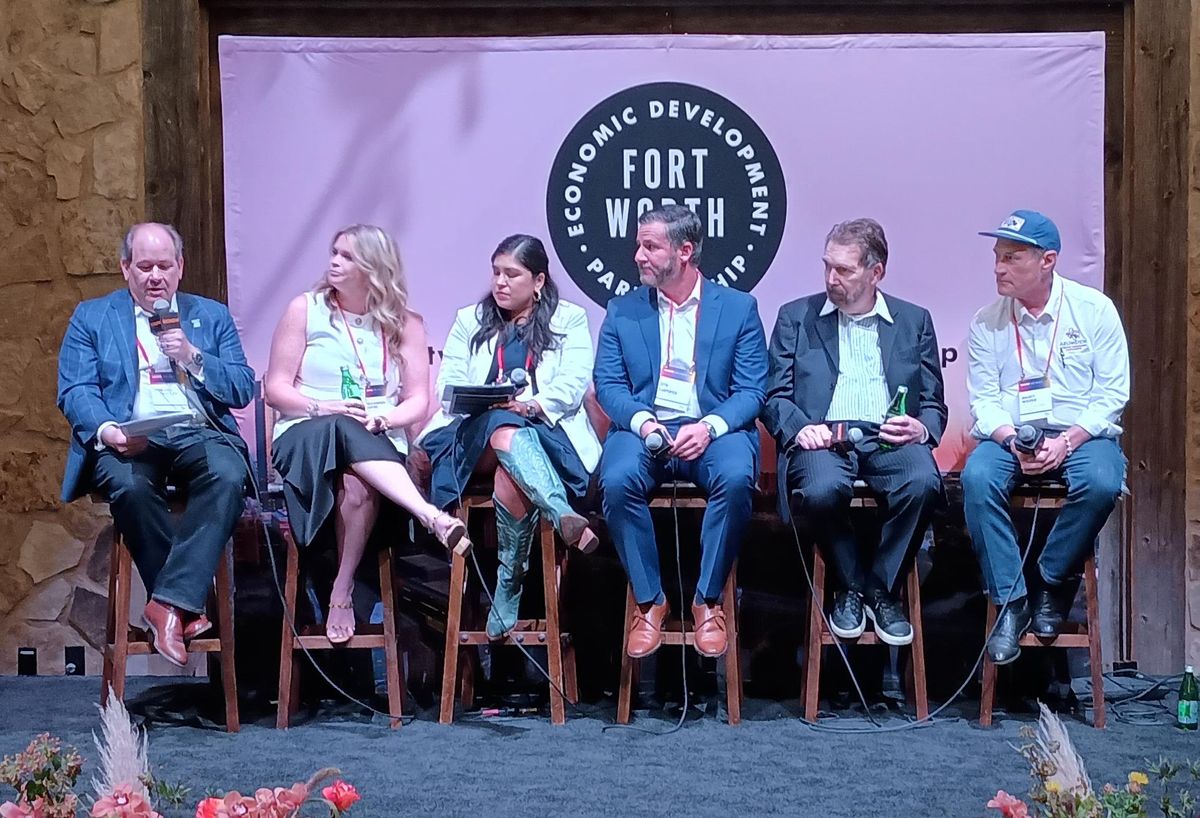When Younger Partners bought Artisan Circle, it was struggling.
The 288K SF mixed-use development in the Fort Worth Cultural District had lost a lot of tenants in the pandemic and was less than three-quarters occupied when Younger Partners bought it in 2022.
So the firm spent the last three years rebuilding the tenant mix and increasing walkability. The West 7th District had problems with crime after dark, so Younger immediately implemented safety measures to help give the development a more family-friendly environment.
“One of the challenges was getting the momentum shifted back around and making that a place that Fort Worth could be proud of,” co-Managing Partner Moody Younger said during Bisnow’s Tarrant County State of the Market event Thursday at Hotel Drover in Fort Worth.

Bisnow/Billy Wadsack
Weaver’s Howard Altshuler, Zang Adams Real Estate’s Kelsi Robinson Couture, Trademark Property Co.’s Monica Luera, Republic Property Group’s Seth Carpenter, Valencia Hotel Collection’s John Keeling and Arlington Economic Development Corp.’s Marty Wieder.
While not every tenant he signed for Artisan Circle has worked out, Younger said he feels the development has turned a corner. He teased that he expects three restaurants and a high-profile retailer will be announced at the development in the coming weeks.
Younger and other Fort Worth developers said a successful mixed-use project is all about the blend, both the variety of businesses and property types within the project, but also how it incorporates into a neighborhood.
The right mix of restaurants and experiences will help activate projects and draw in visitors from other parts of the city and regions of the country, speakers said at the event. Anchoring a mixed-use project with a popular restaurant will also bring residents in the development’s multifamily portion down to the retail portion regularly.
Younger said he considers who eats at the dining establishments and tries to add retail that those people will enjoy.
The way retail is worked into a mixed-use development is also important. Instead of “stuffing” retailers at the base of a residential building, Merriman Anderson Architects Director of Design John Carruth said his firm looked at the asset class as its own piece of the puzzle at the 16-story luxury Thirty-One Eleven Sunset multifamily tower in Flower Mound. The firm then added residential units to the retail.

Bisnow/Billy Wadsack
Winstead PC’s Ryan Goins, Merriman Anderson Architects’ John Carruth, Younger Partners’ Moody Younger and M2G Ventures’ Amber Calhoun.
Finding the right balance also makes a district appealing to office users and people looking for a hotel.
“There’s synergy with all that,” Younger said, adding that he believes the Fort Worth Cultural District could support more hotels, as it is a premier destination for visitors from around the country.
Hotels can be an important element in elevating mixed-use projects, as they are often the first experience visitors have in a new city, Carruth said.
“That’s their first introduction into the next retail experience they’re going to have,” he said.
While Merriman is working on the One University mixed-use development in Fort Worth’s West 7th District, he said not every project needs to include multiple uses. Developers can often get the effect of a mixed-use project by playing off their neighbors.
“You can’t have the biggest amenity area [on] every single project, but you can do things to help complement each other and create a great sense of community around all the different developments,” Carruth said, noting successful hotels often do that well.
One University is slated to have a 171-key hotel, 120K SF of Class-A office space, 254 multifamily units and 12K SF of retail and restaurants.
Younger praised the One University project for the way it is being incorporated into the West 7th District.

Bisnow/Billy Wadsack
Tarrant County College’s Pam Anglin, University of Texas at Arlington’s Jennifer Cowley, Texas A&M University-Fort Worth’s Robert Ahdieh, Phantom Space’s Worth Wray and Kensington Vanguard National Title’s Zach Sams.
“You’re building something new and you’re really capitalizing on what the market demands over there,” Younger said.
It is also important to connect residents in mixed-use developments with the tenants and the wider community to create a cultural relationship. However, that is easier said than done in most cases, Carruth said. Experiences need to be curated without seeming as though they were.
“It really comes down to an almost philosophical look at how you program the spaces without programming them,” Carruth said. “Because they have to be versatile, they have to be able to change, and they have to be able to grow.”
There is an art to it, as programming has to be done with a purpose of creating reasons for people to go to a development, he said.
Plentiful parking is also a major factor in attracting regular visitors, as mixed-use projects can’t survive on their residents alone.
Parking has proven to be a vital element to the success of Artisan Circle, Younger said. His firm has even invested in technology to make it easier for visitors to know where they can park and quickly find a spot.
However, parking isn’t always a necessity, as M2G Ventures Vice President of Leasing Amber Calhoun can attest from overseeing leasing for the Mule Alley portion of the Fort Worth Stockyards Historic District.
“We don’t have parking down here, but we have 9 million visitors, so they’re figuring it out,” Calhoun said.
